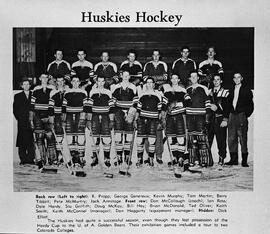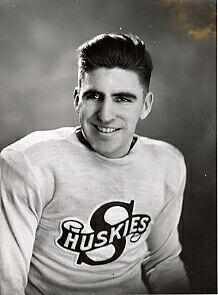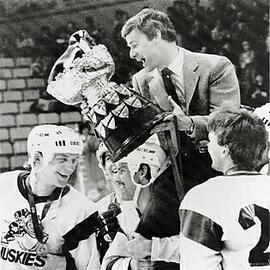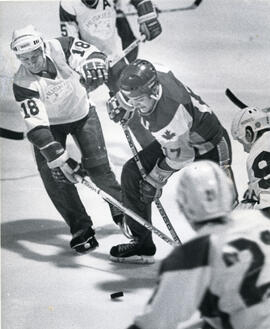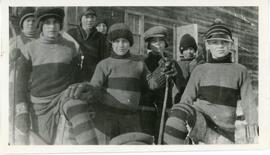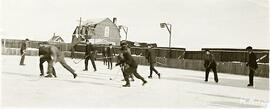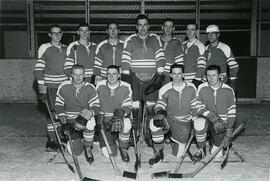The fonds, related to the Swift Current Oldtimers Hockey Association, were accumulated by the source. No other information was captured at the time of transfer to the Swift Current Museum.
The content has not been professionally appraised, arranged, or described. The following is a basic listing of the unprocessed contents:
Box #1.
Discrete items:
- Swift Current Old-Timers Hockey Association (SCOTHA) annual meeting minutes, 2008
- Photocopy of Bud McEwan’s scrapbook
Photographs:
- Old Time Hockey members, all individuals are unidentified
- Poster-sized photo, Swift Current Blues hockey team, caption reads “Winner “F” Division/Western Canada International Tournament/Saskatoon”, individuals are as follows: front row – Gerry Schultz, Ed Schwab, Hap Edwards, Les Wall, Don Cowan, middle row - Dusty Bitz (trainer), Mel Davis, Joe Loustel, Wayne Lambert, Glen Davis (coach), Ron Ross, Don Robertson, Pete Weber, back row – Gord Hoffert, Ray Reeder, Wayne Burns, Mike Franko, Bill Forester, Al Friesen, (rolled – labels are attached in a separate envelope)
- Swift Current Blues hockey team, all individuals are unidentified, with a mat
- Swift Current Blues hockey team, at the 3rd Western Canada Oldtimers Tournament, Victoria BC., 1979, all individuals are unidentified
- Swift Current Blue hockey team, at the Molson Canadian Invitational in Calgary AB, 1987, all individuals are unidentified (discrete item)
Volume 1.
-Ledger, 1976 – 1980, plus information on individual players
Volume 2.
-Ledger, 1980 – 1991
Envelope 1.
-Miscellaneous documents pertaining to the SCOTHA
-Program for a hockey game between Swift Current Old Timers and Montreal Canadiens Old Timers
-Constitution
-Correspondence from Saskatchewan Amateur Hockey Association
Envelope 2.
-Receipts, tournament lists, bank statements from 2000 – 2007
Envelope 3.
-Bank statements, receipts, correspondence, memberships and tournament lists, 1990 – 1999
Envelope 4.
-Bank statements, receipts, tournament lists, correspondence, 1986 – 1989
Envelope 5.
-Bank statements, receipts, tournament lists, 1981 – 1985
Envelope 6.
-Bank statements, correspondence, receipts, membership lists, 1974 – 1980
Box 2.
Folder #1.
-Tournament lists and information, 2002
Folder #2.
-Attendance forms, 1998 – 2001
-Team rosters, 1999 – 2000
-SCOTHA tournament information, 1999
Folder #3.
-Empty
Folder #4.
-Correspondence, tournament information, 1991 -1996
-SCOTHA minutes, 1978 – 1979
Folder #5.
-SCOTHA and Golden Oldies membership lists, 1985 – 1986
-Correspondence, 1980 – 1981
-Miscellaneous documents, ca. 1979 - 1981
-Tournament information, 1989
-Financial information, 1985 – 1986, 1988
-Score sheets, 1988
Folder #6.
-Receipts and financial information, 1991
-Rosters for other teams in the Canadian Old Timers’ Hockey Association league, 1991
-Tournament information and score sheets, 1990 - 1991
-Rental information, 1991
-Bank statements and financial information, 1990 – 1991
Folder #7.
-Tournament score sheets, 1992
-Rosters for other teams in the Canadian Old Timers’ Hockey Association league, 1992
-SCOTHA minutes, 1992
Folder #8.
-Tournament information and score sheets, 1993
-Rosters for other teams in the Canadian Old Timers’ Hockey Association league, 1993
Folder #9
-Tournament score sheets, 1994
Folder #10
-Financial information, 1993 – 1994
-Tournament information and score sheets, 1993 – 1994
-SCOTHA minutes, 1994
-Tournament score sheets, 1995
Folder #11
-Invitation to a tournament in Coaldale, AB, 1995
-SCOTHA minutes, 1995
-Tournament information, 1995
-Tournament score sheets, 1996
Folder #12
-Rosters for other teams in the Canadian Old Timers’ Hockey Association league, 1997 - 1999
-Tournament score sheets, 1999
-Tournament score sheets, 1998
-Tournament score sheets, 1997
Folder #13
-Tournament information, 2003
-Correspondence, etc., re: tournaments, 1997 - 1999
-Receipt books, 1999 – 2002, 2004
-Notebook to keep track of bar supplies
Folder #14
-Tournament schedule, 2001
-Rosters for other teams in the Canadian Old Timers’ Hockey Association league, 2001
-Document, “Important Information For Teams & Game Officials”
-Correspondence, 2001
-Tournament score sheets, 2001
-Photographs #3 – 4

